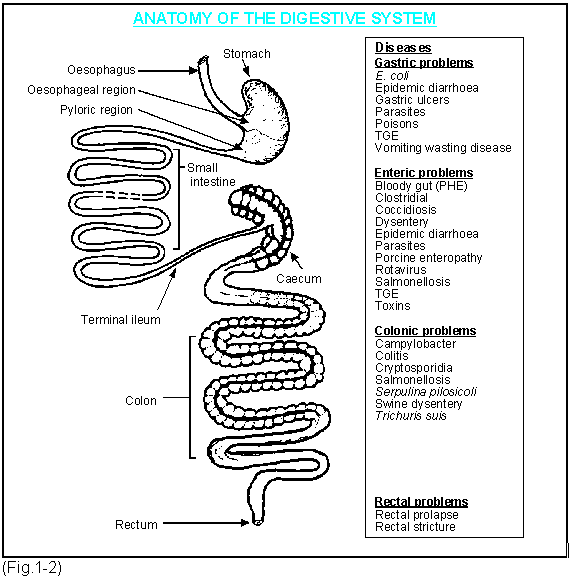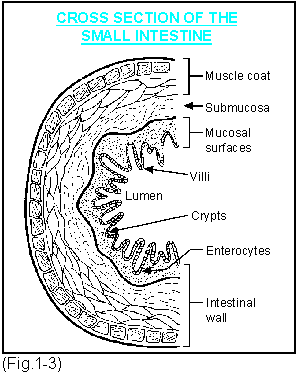



Digestive system
The digestive tract can be considered as a tube that starts at the mouth and finishes at the rectum (Fig.1-2). In some respect its contents can be considered as outside the body. The back of the mouth opens into the pharynx which is the common area for the passage of both food and air. A valve or flap of tissue called the soft palate automatically moves to protect the opening into the trachea or windpipe when swallowing. The tonsils of the pig are situated on the surface of the soft palate. The oesophagus is the tube that leads from the pharynx to the stomach, down which food is propelled.
The main infectious diseases of the mouth are the vesicular ones including foot-and-mouth disease and swine vesicular disease, although occasionally lesions on the skin around the mouth may be seen in aujeszky's disease and porcine reproductive and respiratory syndrome PRRS. Infection of both the gums and bones are common following faulty teeth clipping.

The digestive system of the pig has the ability to convert vegetable and animal materials into highly digestible nutrients. Its anatomy and physiology are similar to that of humans. In the stomach the major disease problems are associated with inflammation of its lining called gastritis which may result in vomiting. Vomiting also occurs in systemic disease where the organism has spread throughout the body (in infections such as erysipelas), and from toxins produced by bacteria or during high fevers.
Gastric ulceration is common in growing pigs occurring in the area where the oesophagus enters the stomach (oesophageal region).

The intestine has two distinctive parts, the small and the large intestine. Inflammation of the former is called enteritis (although sometimes enteritis may mean inflammation of both parts) and the latter colitis. Enteritis is very common and caused by specific viral, bacterial or parasitic infections. The small intestine in cross section contains millions of finger like projections called villi. (Fig.1-3). These increase the absorptive area enormously and thus the efficiency of the digestive process. The large bowel or colon commences with the caecum, the area of the intestinal tract responsible for the digestion of cellulose. Two diseases are commonly seen in the rectum particularly in growing pigs, rectal stricture and rectal prolapse, both of which are discussed in chapter 9.
Terminology
Ascites - Fluid in the abdomen.
Atrophy - A loss of tissue due to disease or malfunction. Atrophy of the villi in the intestine occurs at weaning time causing malabsorption.
Bloody gut - A descriptive term applied to haemorrhage in the lower part of the small intestine or the complete digestive tract. The latter is seen where there is complete torsion of the intestines. Porcine enteropathy is a common cause. (See chapter 9).
Carbohydrates - These consist of two types, crude fibre and soluble carbohydrates. Crude fibre is a mixture of cellulose. Cellulose digestion takes place in the large intestine.
Caecum - A blind sac, at the beginning of the large intestine.
Colitis - Inflammation of the colon or first part of the large bowel. The caecum is often inflamed at the same time (typhlitis). This is a common condition in young growing pigs from 20-60kg weight, caused by nutritional factors and/or infectious agents.
Colon - The spiral part of the large intestine.
Crypts - The bases of the villi.
Duodenum - This is the first part of the small intestine.
Enteritis - Inflammation of the small intestine. This leads to diarrhoea which is common in sucking pigs, weaners and growers.
Enterocytes - Cells at the base or crypts of the villi in the intestine. They multiply and maintain the length of the villi.
Gall bladder - An organ attached to the liver which produces bile that helps in the digestion and absorption of fats.
Gastric ulcers - Erosions of the mucous lining of the stomach occurring mainly in the oesophageal region. Very common and if severe they result in haemorrhage and death.
Gastritis - Inflammation of the stomach lining. Often causes vomiting.
Gingivitis - Inflammation of the gums.
Glossitis - Inflammation of the tongue.
Hepatitis - Inflammation of the liver.
Ileitis - Inflammation of the ileum.
Ileum - The terminal part of the small intestine.
Jejunum - The middle part of the small intestine.
Liver - This organ is the main factory of the body, building new materials and degrading old ones.
Lignin - See carbohydrates.
Lumen - The open space of the small intestine.
Mucosa - The internal lining of the digestive tract. The cells produce mucus which lubricates the surface and also protects against many pathogenic organisms.
Oesophagus - The muscular tube from the pharynx to the stomach.
Omentum - A reflected net-like membrane from the peritoneum that covers the stomach and intestine.
Pancreas - A gland attached to the duodenum by a tube, which produces digestive enzymes and insulin.
Pars oesophagus - The area of the stomach near the entrance of the oesophagus. A common site for the development of ulcers.
Peritoneum - This is the smooth shiny membrane that covers all the surfaces of the abdomen and its contents.
Peritonitis - Inflammation of the peritoneum.
Pharynx - The common passage for food and air at the back of the throat.
Proteins - These are composed of amino acids which contain carbon, hydrogen, oxygen, sulphur, nitrogen and phosphorus. Combinations of different amino acids produce different proteins.
Pyaemia - Invasion of pus producing organisms throughout the body with small abscess formations.
Soft palate - The flap of tissue that separates the trachea and the oesophagus. It contains the tonsils.
Salivary glands - There are three of these called the parotid, mandibular and sublingual glands. They secrete saliva into the mouth.
Tonsillitis - Inflammation of the tonsils.
Tonsils - Two patches of lymphatic tissue at the back of the throat on the soft palate.
Villi - Finger like projections into the lumen of the small intestine. (Fig.1-3).







